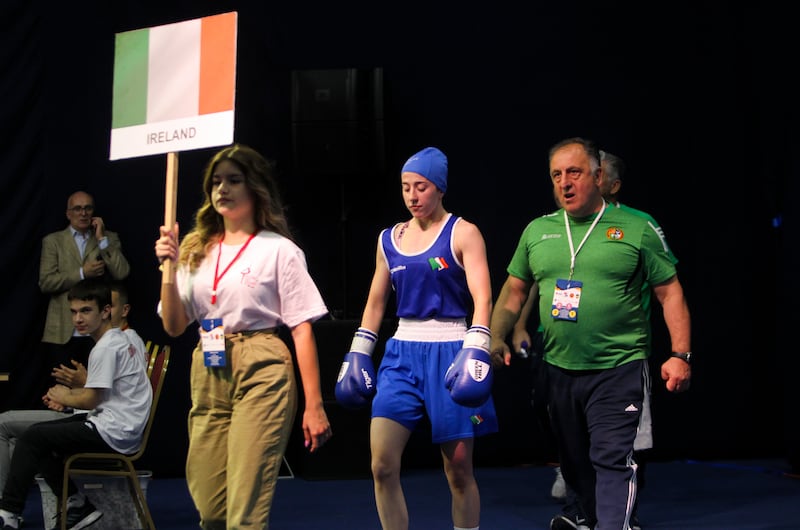Seven medallists, four more than in any other women’s European Championships and five of those into the European final. Those who don’t normally look towards the sport might reasonably ask where exactly the crisis is in Irish boxing.
Blaring headlines of funding cuts and resignations have peppered the media for the past two years. The chief executive of the Irish Athletic Boxing Association (IABA) Fergal Carruth and its chairman, John Kirwan, offered their resignations. High performance coach Bernard Dunne, who would have worked with many of the Irish team including Harrington, resigned, and last week left Ireland to head Indian Olympic boxing.
The association voted against recommendations to reform and modernise the running of the sport, prompting a 15 per cent cut in government funding. Now, far from any of those cracks appearing at competition level, the Irish boxing team are in Budva, Montenegro with seven bronze and a minimum of five silver medals.
In one sense it shows the disconnect between the athletes and the administration, no matter how faulty it may appear. A sport in apparent disarray, yet the boxers have transcended the mess of governance and surpassed every marker in the competitive space that was previously set — three medals at the 2019 European Championships. This week has been a story of athletic success in the ring despite the grating and din of background noise and rancour.
READ MORE
What boxing has shown since the Olympic rebound last year in Tokyo, and also in Istanbul at the World Championships earlier this year, is that behind the administration of the sport and the infighting at board level, the coaches around the country such as Mike Mongan in Galway, have never stopped doing what they do best and the coaches in the high performance unit with Zaur Antia and John Conlan the most visible senior pair, not slowing down in the dissemination of their vast experience.
There is little doubt women’s boxing has been one of the recent successes in the ongoing Irish sporting narrative. It was just 10 years ago that Katie Taylor was winning the gold medal in the London docklands when no other Irish female boxer’s name had entered the public consciousness.
Seven medals from a team of 10 athletes is a richer return than any other Irish sport has ever achieved
Then things started to happen and earlier this year Amy Broadhurst and Lisa O’Rourke popped their heads up when they became world champions, while O’Rourke’s older sister Aoife became European champion in 2019.
Broadhurst, of St Bronagh’s ABC, Rostrevor, and O’Rourke of Olympic, Galway, overcame opponents from Algeria and Mozambique, respectively for world gold and doubled Ireland’s previous world champion numbers.
Both Broadhurst, who was the first Irish boxer to win her semi-final on Friday to secure a place in the light welterweight final, and the O’Rourkes are really children of Taylor, who won her first world championship in India in 2006 before Kellie Harrington came along in 2018, also in India, to add a second world gold.

Broadhust at 25-years-old is 10 years younger than Taylor (36) and Lisa O’Rourke (not in Montenegro), at 20 is 16 years younger than Taylor.
Lisa remembers watching Taylor as a child with her parents on their farm in Roscommon but not fully understanding at the time what seismic changes for women were taking place in the sport.
Harrington, who would have been a competitor with Taylor for the lightweight nomination, at 32 carried the torch onwards in Olympic boxing and from those important figureheads the idea that anything could be achieved at world and European level became realistic and attainable.
That has played out this week and the conversion rate of team members to medals has been stunning. There is just one caveat, and it does not take from the outsized achievement. Because of the war in Ukraine, Russia and Belarus do not have boxers at the championships, which takes out a number of podium contenders. Ukraine is in the competition, although none of Ireland’s seven semi-finalists faced a Ukrainian boxer.
Seven medals from a team of 10 athletes is a richer return than any other Irish sport has ever achieved. To find something comparable, boxing would have to look at the 2012 Olympic Games where Taylor won gold, John Joe Nevin silver and Michael Conlan and Paddy Barnes bronze.
What the Irish team has also managed to do is increase the depth of the talent pool and introduce new names capable of reaching deep into draws at international level.

Among the emerging faces in Montenegro are southpaw Shannon Sweeney from St Anne’s, Mayo competing in the minimum weight 48kg at her first European Championships and Immaculata’s bundle of energy at light flyweight, Caitlin Fryers, joining legendary Immaculata fighter Jim McCourt as a European medal winner.
What the medals also do for those boxers with Olympic qualification coming in the next 18 months is to put them on an Olympic pathway and, if they are not already carded athletes, qualify for Sport Ireland funding. The Olympics will require some adjustment as not all the weight divisions in Montenegro will be available for Paris 2024 and that will be a work in progress over the coming months as athletes move up and down the kilos to try to make the coveted Olympic categories.
Five Irish boxers contesting finals on the last day of the European Championships with several of those wholly expected to upgrade their silver to gold. That, as former Irish head coach to the Irish rugby team, Joe Schmidt, used to say, is a nice headache.
















